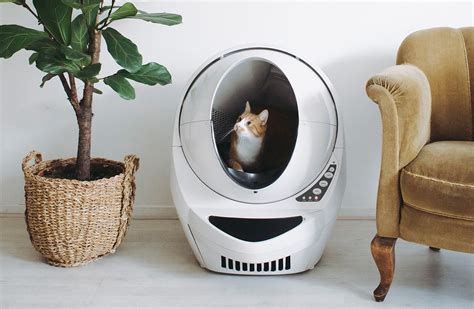Introduction

In the era of smart homes, the integration of robotic technology into household appliances has become increasingly prevalent. One such advancement is the emergence of robot litter boxes, which offer a convenient and hygienic solution for cat owners. This article explores the integration of robot litter boxes with smart home systems, discussing their advantages, features, and implications for the future of pet care.
Advantages of Robot Litter Box Smart Home Integration
-
Automated Cleaning: Robot litter boxes automatically scoop and dispose of waste, eliminating the need for manual cleaning. This saves time and effort for pet owners.
-
Odor Control: Advanced litter boxes have built-in odor-control systems that absorb and neutralize unpleasant smells, ensuring a cleaner and fresher home environment.
-
Health Monitoring: Some litter boxes incorporate sensors that track the frequency and consistency of cat waste, providing valuable insights into their health and well-being.
-
Remote Access: Smart litter boxes allow owners to monitor and control their devices remotely via smartphone apps. This is particularly convenient for pet owners who are away from home or have multiple cats.
Features of Smart Robot Litter Boxes
-
Self-Cleaning Mechanism: Robot litter boxes use a variety of mechanisms to clean the litter, such as rakes, sifters, and scoops. Some models offer multiple cleaning modes to suit different cats’ preferences.
-
Waste Disposal Systems: Robot litter boxes typically have built-in waste storage containers or connect to external disposal systems. This eliminates the need for frequent emptying.
-
Odor-Control Filters: Activated carbon filters, HEPA filters, and ionizers are common features in robot litter boxes, effectively trapping and neutralizing odors.
-
Health Monitoring Sensors: Some litter boxes incorporate sensors that monitor waste volume, consistency, and frequency. This data can be analyzed to detect changes in a cat’s health and alert owners.
Integration with Smart Home Systems
Robot litter boxes can integrate with various smart home ecosystems, including Amazon Alexa, Google Home, and Apple HomeKit. This integration allows for voice control, automated cleaning schedules, and access to information about the litter box’s status.
Impact on the Future of Pet Care
The integration of robot litter boxes with smart home systems is expected to revolutionize pet care in the years to come. By automating cleaning tasks and providing health insights, these devices will enhance the well-being and convenience of both cats and their owners.
Case Details
-
Litter-Robot 3 Connect: This advanced litter box features a rotating drum that automatically separates waste from clean litter. It connects to the Litter-Robot app for remote monitoring and automated cleaning.
-
Petkit Pura Max: The Petkit Pura Max is a fully-enclosed litter box with sensors that monitor odor, waste volume, and waste consistency. It integrates with the Petkit app for real-time updates and health alerts.
Step-by-Step Guide to Integrating Robot Litter Box with Smart Home
- Select a smart litter box and purchase it.
- Download the companion app for your smartphone.
- Follow the app’s instructions to connect the litter box to your Wi-Fi network.
- Create an account and register your device.
- Configure cleaning schedules and other settings as desired.
Comparison of Robot Litter Boxes
| Robot Litter Box | Features | Pros | Cons |
|---|---|---|---|
| Litter-Robot 3 Connect | Self-cleaning, odor-control, health monitoring, app integration | Automated cleaning, large capacity, health insights | High initial cost, requires proprietary litter |
| Petkit Pura Max | Self-cleaning, odor-control, health monitoring, completely enclosed | Fully enclosed design, advanced sensors, app integration | Smaller capacity than Litter-Robot, requires electricity |
Pros and Cons of Robot Litter Boxes
Pros:
- Convenience and time-saving
- Improved odor control
- Health monitoring capabilities
- Remote access and control
- Integration with smart home systems
Cons:
- Higher initial cost than traditional litter boxes
- Potential for mechanical issues
- Proprietary litter may be required
- May not be suitable for all cats
FAQs
-
Are robot litter boxes worth the investment?
It depends on individual preferences and needs. Robot litter boxes offer convenience, odor control, and health monitoring, but they come at a higher initial cost. -
How often should I clean a robot litter box?
Most robot litter boxes require minimal cleaning, with some models only needing emptying once every few weeks. -
Can robot litter boxes be used with any type of litter?
Some robot litter boxes require specific types of litter for optimal performance. Check the manufacturer’s recommendations before using your preferred litter. -
How do I troubleshoot a robot litter box?
Refer to the manufacturer’s instructions or contact customer support for troubleshooting assistance. -
What is the average lifespan of a robot litter box?
With proper maintenance, robot litter boxes can last for several years. -
Are there any health risks associated with robot litter boxes?
No, robot litter boxes do not pose any known health risks to cats or humans.
Market Insights
According to a 2022 report by the American Pet Products Association, the U.S. pet industry is expected to reach $123.6 billion in sales by 2025. The market for smart pet products, including robot litter boxes, is growing rapidly due to increasing pet ownership and the adoption of smart home technology.
Conclusion
The integration of robot litter boxes with smart home systems represents a significant advancement in pet care. These devices offer convenience, odor control, health monitoring, and remote access, enhancing the well-being and convenience of both cats and their owners. As the smart home ecosystem continues to evolve, we can expect further innovations in robot litter box technology and its impact on the future of pet care.





















